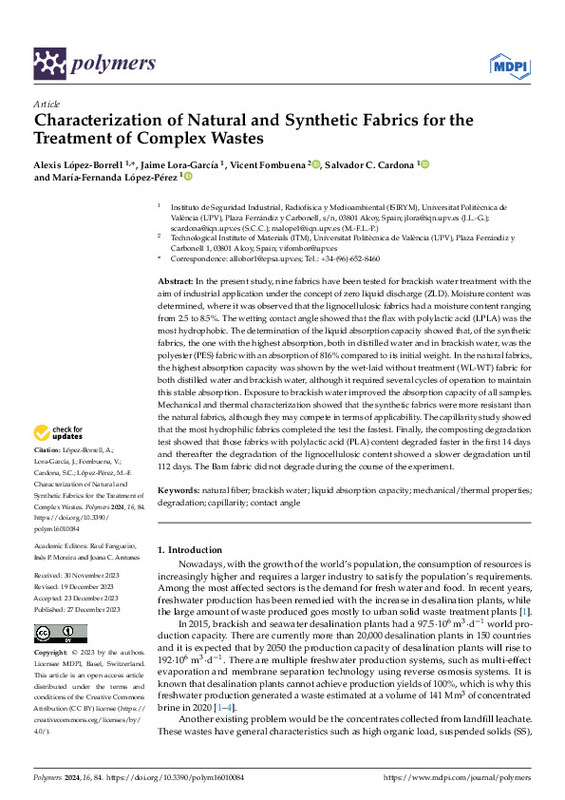JavaScript is disabled for your browser. Some features of this site may not work without it.
Buscar en RiuNet
Listar
Mi cuenta
Estadísticas
Ayuda RiuNet
Admin. UPV
Characterization of Natural and Synthetic Fabrics for the Treatment of Complex Wastes
Mostrar el registro sencillo del ítem
Ficheros en el ítem
| dc.contributor.author | López-Borrell, Alexis
|
es_ES |
| dc.contributor.author | Lora-García, Jaime
|
es_ES |
| dc.contributor.author | Fombuena, Vicent
|
es_ES |
| dc.contributor.author | Cardona, S. C.
|
es_ES |
| dc.contributor.author | López-Pérez, Maria-Fernanda
|
es_ES |
| dc.date.accessioned | 2024-01-29T19:01:11Z | |
| dc.date.available | 2024-01-29T19:01:11Z | |
| dc.date.issued | 2024-01 | es_ES |
| dc.identifier.uri | http://hdl.handle.net/10251/202206 | |
| dc.description.abstract | [EN] In the present study, nine fabrics have been tested for brackish water treatment with the aim of industrial application under the concept of zero liquid discharge (ZLD). Moisture content was determined, where it was observed that the lignocellulosic fabrics had a moisture content ranging from 2.5 to 8.5%. The wetting contact angle showed that the flax with polylactic acid (LPLA) was the most hydrophobic. The determination of the liquid absorption capacity showed that, of the synthetic fabrics, the one with the highest absorption, both in distilled water and in brackish water, was the polyester (PES) fabric with an absorption of 816% compared to its initial weight. In the natural fabrics, the highest absorption capacity was shown by the wet-laid without treatment (WL-WT) fabric for both distilled water and brackish water, although it required several cycles of operation to maintain this stable absorption. Exposure to brackish water improved the absorption capacity of all samples. Mechanical and thermal characterization showed that the synthetic fabrics were more resistant than the natural fabrics, although they may compete in terms of applicability. The capillarity study showed that the most hydrophilic fabrics completed the test the fastest. Finally, the composting degradation test showed that those fabrics with polylactic acid (PLA) content degraded faster in the first 14 days and thereafter the degradation of the lignocellulosic content showed a slower degradation until 112 days. The Bam fabric did not degrade during the course of the experiment. | es_ES |
| dc.description.sponsorship | This research work was funded by the Ministry of Science and Innovation, "Retos de la Sociedad". Project reference: PID2020-119142RA-I00. | es_ES |
| dc.language | Inglés | es_ES |
| dc.publisher | MDPI AG | es_ES |
| dc.relation.ispartof | Polymers | es_ES |
| dc.rights | Reconocimiento (by) | es_ES |
| dc.subject | Natural fiber | es_ES |
| dc.subject | Brackish water | es_ES |
| dc.subject | Liquid absorption capacity | es_ES |
| dc.subject | Mechanical/thermal properties | es_ES |
| dc.subject | Degradation | es_ES |
| dc.subject | Capillarity | es_ES |
| dc.subject | Contact angle | es_ES |
| dc.subject.classification | INGENIERIA QUIMICA | es_ES |
| dc.title | Characterization of Natural and Synthetic Fabrics for the Treatment of Complex Wastes | es_ES |
| dc.type | Artículo | es_ES |
| dc.identifier.doi | 10.3390/polym16010084 | es_ES |
| dc.relation.projectID | info:eu-repo/grantAgreement/AEI/Plan Estatal de Investigación Científica y Técnica y de Innovación 2017-2020/PID2020-119142RA-I00/ES/EVAPORACION NATURAL ASISTIDA CON MATERIALES ABSORBENTES DE BAJO COSTE PARA EL TRATAMIENTO DE EFLUENTES CONCENTRADOS DE GESTION COMPLEJA/ | es_ES |
| dc.rights.accessRights | Abierto | es_ES |
| dc.contributor.affiliation | Universitat Politècnica de València. Escuela Politécnica Superior de Alcoy - Escola Politècnica Superior d'Alcoi | es_ES |
| dc.contributor.affiliation | Universitat Politècnica de València. Departamento de Ingeniería Química y Nuclear - Departament d'Enginyeria Química i Nuclear | es_ES |
| dc.description.bibliographicCitation | López-Borrell, A.; Lora-García, J.; Fombuena, V.; Cardona, SC.; López-Pérez, M. (2024). Characterization of Natural and Synthetic Fabrics for the Treatment of Complex Wastes. Polymers. 16(1):1-25. https://doi.org/10.3390/polym16010084 | es_ES |
| dc.description.accrualMethod | S | es_ES |
| dc.relation.publisherversion | https://doi.org/10.3390/polym16010084 | es_ES |
| dc.description.upvformatpinicio | 1 | es_ES |
| dc.description.upvformatpfin | 25 | es_ES |
| dc.type.version | info:eu-repo/semantics/publishedVersion | es_ES |
| dc.description.volume | 16 | es_ES |
| dc.description.issue | 1 | es_ES |
| dc.identifier.eissn | 2073-4360 | es_ES |
| dc.identifier.pmid | 38201749 | es_ES |
| dc.identifier.pmcid | PMC10780343 | es_ES |
| dc.relation.pasarela | S\506234 | es_ES |
| dc.contributor.funder | AGENCIA ESTATAL DE INVESTIGACION | es_ES |








